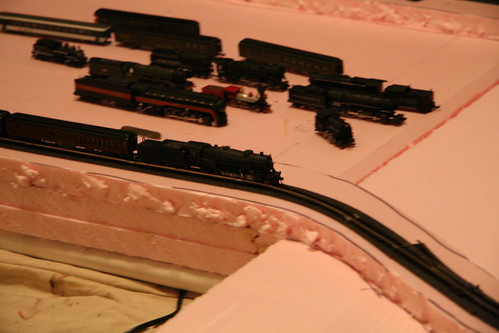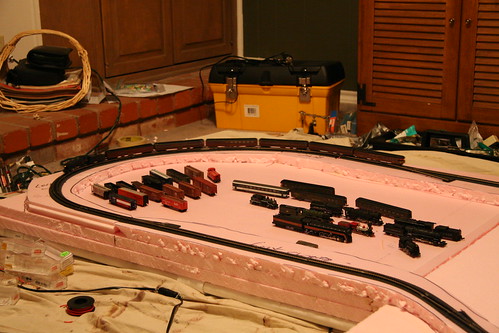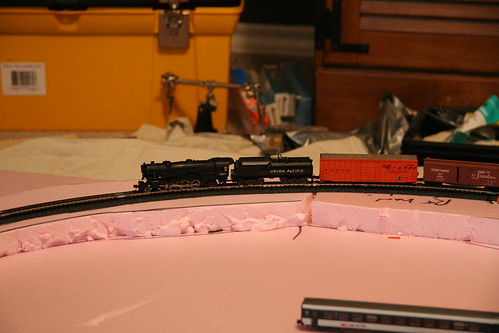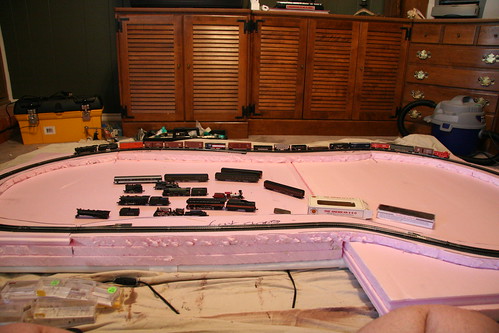Saturday, June 13, 2009
A whole lot 'o nuthin.
Well, sort of. Here’s the situation as it is now:
As I may have reported previously here (I’m far too lazy to reread my updates!), the ½ in. PVC pipes that I got to form legs simply won’t cut it. The whole rig is far too wobbly to be of use. So it’s back to the drawing board. My new I idea is to construct a table-like uh…construction using PVC. Of course, this time, I will use a larger diameter of PVC pipe—perhaps even two inches. I should be able to build a fairly strong frame using this method that the layout will simply sit on.
If that method fails, I guess I’m going to buy a portable table. But right now, I can’t do anything, because I simply don’t have the funds to purchase either a table or the PVC. Other things have to come first. You know. Like….eating. And Air Conditioning.
In the meantime, I still haven’t figured out a track plan for the interior of the loop that I have completed. I have a few general ideas, but nothing concrete. I’ve kind of been holding off on working on anything until I get the base built. So it will be awhile. But hey, Rome wasn’t built in a day, as the cool kids say.
Anyway, I’m not too concerned about the lack of progress. Model Railroading is a long-term hobby. If you’re looking for instant gratification, this isn’t the hobby for you. It takes planning, time, effort, and money to build a model railroad. So when these are lacking, it’s time to sit back, read the most recent copy of MR, and dream.
Tuesday, June 2, 2009
Some ramblings
Anyhow, I though I would write down some thoughts about various things.
On the subject of DCC:
Earlier in the blog I mentioned that I was considering switching to DCC. Sense then, I think I’ve decided against it. But I thought it would be worth writing about exactly why.
I suppose I should begin by explaining just what the heck “DCC” is, for those not in the know. Essentially, DCC is another method of powering a model railroad. Our models are much too small to contain real boilers, fires, steam, etc. (at least in N scale—there is such a thing as live steam in HO!). So to make the train go, we use a conventional motor controlled by DC current. Turn the knob on your powerpack, the voltage rises, and the motor spins faster. Simple.
So what’s wrong with DC? Well, it’s great if you have one train on one piece of track. But what if you want to control two trains? Then things get a little tricky. All of the track has to be separated into multiple “blocks” of electricity. You can then use two powerpacks to control two trains. But of course you have to make sure you have the block switched to the right powerpack. And of course your trains can only be as close as your power blocks are. Not to mention that following the train and flipping all the correct blocks can be quite tedious. And as you can imagine the resulting rat’s nest of wires is quite a pain to deal with. Ne’ertheless, DC has worked well for decades. It’s fairly easy in that it doesn’t require a huge understanding of technical knowledge to do. And if you just have a power pack and some wires, it’s easy to set up.
But in a model railroad, we strive for realism. And DC operation just isn’t very prototypical. You can’t run locomotives right up next to each other as you can in the “real world.” And switching operations require a lot of fiddling of blocks that simply doesn’t exist in the real world. So although DC works well, it’s not the best solution.
Enter DCC. DCC stands for Digital Command Control. The idea has been around since the 70s, but it’s not until the last decade that it has really taken off. The basic idea is this: every locomotive has “decoder” placed in it, that’s essentially a computer chip. Instead of merely controlling the voltage to the rails, your handheld throttle sends a bunch of zeros and ones (computer code) through the rails. The Decoder decodes these bits and interprets them into signals: run forward at half speed, ring the bell, and so on.
With DCC it’s possible to control each locomotive individually, just like the prototype. It’s a far more realistic way of operating a model railroad. And it makes wiring much easier, too; there are no blocks to worry about and all rails are hooked up to one single power source.
So why am I not jumping on the bandwagon?
Two primary reasons: Cost, and decoder installation.
First of all, I would have to buy a DCC system, which would run about $150 right now. Then each locomotive would require its own decoder, which would be about $15 per locomotive.
That’s money that I simply don’t have to spend right now. So far I’ve spent about $200 or more just on layout building materials and track. So I’ve got to lay off the spending for awhile. Damn this economy.
But even if I had the money, I’d still be wary of converting. The decoders are not simple drop in installations—at least not for steam locomotives. They require lots of fiddling/soldering, etc. And since I run steam, they are all a pain in the butt to install. And that’s not something that I’m interested in.
If I were starting out for the first time with no legacy equipment, You can bet I’d go DCC in a heartbeat. But it’s pretty hard to consider spending all that time, effort, and money to convert right now.
In any case, what did you expect? I’m an old-fashioned romantic who’s stuck in his ways. Change!? Bah!
Speaking of romance, I wanted to touch upon another subject that I’ve been thinking about.
Last week I came upon this website: http://www.terrastories.com/bearings/
It chronicles an “urban adventurer’s” journey through the abandoned world. He breaks into abandoned properties and photographs them as they lie, dormant and untouched save for the ravages of time. There are some stunning photographs on his site of abandoned amusement parts, mansions, and even a Titan missile silo. I found it fascinating, and it made me think about model railroading and why I desire to create in miniature a world that is long gone.
I never got to see the golden age of railroading. By the time I was born in 1983, steam was long gone (at least in the United States) save for tourist railroads. Where I grew up, there wasn’t a huge rail presence. Sure, I’d see long Santa Fe (and later BNSF) Autorack trains on trips, but that was about it. My exposure to trains was strictly through the LGB Large scale trains that we had, and visits to tourist railroads (The earliest of which was a trip on the Durango and Silverton on which I have been told I acted like a complete ass).
So why am I drawn to model railroading, then?
I think the romance has a lot to do with it. A steam locomotive is by definition an element of romance. A steam locomotive isn’t a machine; it’s a living, breathing organism that requires tender care to keep her running well. In the early days, the railroad wasn’t just some nameless transporter of freight. It was the lifeblood of the community. The entire town revolved around it. Passengers coming and going, goods bought and sold. The friendly engineer giving the neighborhood boys a tour of the cab and bringing the younger ones a lollipop once a week, like clockwork. The wife of the conductor baking fresh pies for her husband’s crew, hot and ready-to-eat when they returned from a long and grueling day hauling coal over the Appalachians. And so on, and so on.
These scenes are gone from the visage of American History. The number of people living that now remember these times dwindles every year. I think this plays a large part of why I’m drawn to the idea of recreating these idyllic times in a miniature world of my own design. It’s a chance to not only remember and pay tribute to these bygone eras, but perhaps to somehow vicariously experience the very feelings and emotions of them, too.
So right now, I can only watch my trains rolling around the pink foam plains. But if I squint my eyes, I can see the green mountains, the black soot of coal; I can hear the chimes of the end-of-shift bell at the mine. I can smell the ocean air blowing in from the coast, the salt tickling my nostrils. The world that was once dead is summoned to life once again. As long as it exists in my own miniature world, it will never truly be gone.
I suppose this entry has gone on long enough, so lets call it the end for now…
Wednesday, May 20, 2009
Tuesday, May 19, 2009
Golden Spike
Saturday morning dawned grey and rainy—a perfect day for staying inside and working on projects. I spent part of the morning working on a structure kit. It’s nearly finished now—just needs a roof and some figures and it will be done. After lunch, I ventured outside to go get wire at the local Radio Shack. I picked up some spools of 22 gauge solid, and 18 gauge stranded. I also got a new tip for my soldering iron.
When I got back, I had to figure out exactly how I was going to wire the thing. Right now, I just have one loop of track. Since that was the case, I decided to forego any sort of cab control and just wire it as one block. (I’m also toying with the idea of converting to DCC, in which case everything would be wired as one “block” anyway). When I get some more track, it will be easy to convert to cab control without having to tear everything out.
I decided to attach four sets of feeders to the rails. I dug out holes with a screwdriver (foam is great…no powertools here!) and fed pairs of red/black 22 gauge solid through them. The Solid core copper wire is much easier to solder to the sides of the rail than the stranded stuff. I had my first set of feeders fed through, so I plugged in the soldering iron and POP there was a flash of light. I cursed as I realized I had shorted out the soldering iron. Which meant yet another trip to Radio Shack!
I finally made it back with a new 40 watt iron, and set about the process of soldering the feeders to the rail. Essentially, you coat the rail and the wire with flux paste, then tin them (which means coating with a thin layer of solder), and then attach the wire to the rail without using additional solder. It’s a little more difficult than it sounds, because you have to get the wire positioned correctly whilst holding a 40 watt soldering iron. Have to watch your fingers.
Anyway, the process is fairly straight-forward. My feeders won’t win any awards for neatness but they get the job done, and after ballasting the track they’ll be nearly invisible, anyway.
Once my four sets of feeders were in place, I flipped the layout up and leaned it against the couch, then screwed and glued on three terminal strips to the bottom—one on each end and one in the middle. I used 18 gauge stranded wire to connect everything together, meeting at the terminal strip in the middle, to which I attached a longer cord that has a cinch-jones connector on it (think of a miniature normal wall plug and you’ll get the idea). This makes it easy to hook up the power pack.
Once the wiring was completed, I turned the layout back over, cleaned the rails once with a track-cleaning block, hooked up the ancient MRC Tech-II throttle, and set the Kato Mikado on the rails.
And wouldn’t you know it, it actually worked?
I ran the locomotive back and forth for a few moments, and then I could not help but gleefully tear into my storage box and open up every single piece of rolling stock I have. I’ve got a bunch of stuff that hasn’t been run in years. To my great joy, every locomotive I have actually runs (though some are better than others…the K4 Pacific from the 70s has to go at warp speed to do anything…). Even the Bachmann 4-4-0 does well; I certainly made the right decision about the Electro-frog turnouts, because I haven’t had any stalling on turnouts whatsoever.
I’ve spent the last week simply running trains. There are still some track issues to be addressed, and I need to add some more feeders (which will involve cutting gaps in the rail…more on that another time). But it certainly is a joy to see the Mike pull my set of Pennsy passenger cars, which I haven’t been able to run since at least 2001 (probably before that…)
This blog post wasn’t quite as detailed as I wanted it to be, but I’m exhausted and it’s past my bedtime already. I’ll try to get some pictures put up soon!
Wednesday, May 13, 2009
The Circle is Complete
When we last left off, I had completed a basic outside loop of track. The geometry is a little iffy, so I hope it all works well. It’s a little hard to tell. It would have been much easier to do using flex track, but given my past history of flex track, I really didn’t want to mess with it. Not to mention I can’t GET any without waiting at least a week or driving 200 miles.
In any case, once I had this basic loop, I made a paper template (1:1 scale) of the track and divided it into four basic sections. I took these four templates and laid them out on the spare pieces of 1” thick foam that I had, and traced around them with a sharpie. I placed the foam on a cardboard table, and then took a heavy sharp kitchen knife and cut out the lines. It wasn’t necessary to cut all the way through the foam—just to cut most of the way. Once the lines were cut, I was able to carefully snap the pieces off, just like using the “score and snap” method of cutting styrene.
Side note: I later found that putting my index finger on the top edge of the knife had bored a hole in my skin. Nothing major, but I will certainly cover the knife with a thick towel or something beforehand the next time I cut the foam.
I now laid the foam pieces out in the general shape of the track plan, and attached them to the bottom sheet of foam with Liquid Nails. Once again, thank you Norton Anthologies for finally pulling your weight!
If you’ve never built a layout before, you may be asking, “why elevate the track with another layer of foam?”
Take a look outside. Unless you’re one of the poor souls that live in Lubbock, chances are you can see some chances of elevation in the lay of the land. The “1:1” world is not built on top of plywood. There’s rolling hills, dips and valleys, gorges, mountains, waterfalls, and all kinds of things. In fact, the world is pretty damn bumpy.
Elevating the track up another level makes it much easier to model all these geographic features. Combined with being able to cut out the foam, it’s much easier than trying to build up everything from plywood. This is the first time I’ve actually built a layout like this, so time will tell how it goes.
I let the new pieces of foam dry with the weights on them for a good three days. Two would have probably sufficed, but I had company so I wasn’t able to do anything. The next step was to once again lay out all the track and ensure that it fit. It’s a good thing that I made myself a detailed track plan so there was no doubt as to which pieces went where!
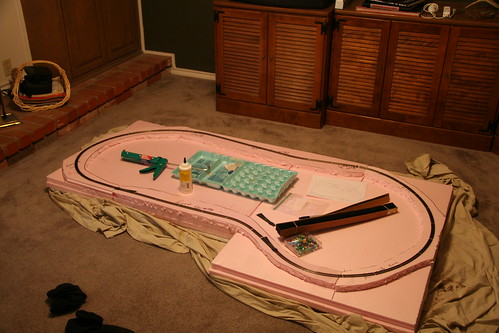
After this track had been laid out and I was reasonably happy with how it looked, I took a sharpie and drew out the plan onto the foam. Working a section at a time, I glued down Woodland Scenics Foam Roadbed. Now, the traditional roadbed material is cork, but I used the foam stuff on my last layout and I really like working with it. It’s very easy to cut, and much easier to curve than cork is. Not to mention cheaper.
The roadbed was held in place with some cheap push-pins that I got at office depot. By the way, I used my 8 year old bottle of foam tack glue, and it still works great. Good stuff. I let the roadbed dry for a few more days. It had to conform to some tight curves, so I wanted to be sure it would stay in the correct spot.
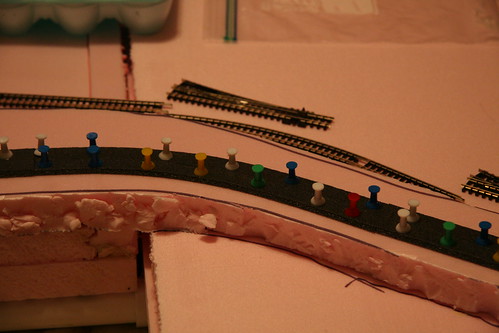
In retrospect, I went about this all wrong. I have several spots where the roadbed simply doesn’t conform to the final position of the track, even though I test-laid the track as I was gluing the roadbed. Next time, I’ll probably lay everything all at once.
While the roadbed was drying, I decided to break out the soldering iron and solder some track together. It’s pretty much the only way to ensure a good electrical connection. I’ve gotten a little better at soldering over the years, but I’m still very much a novice. But I’ve discovered the one great secret to soldering rails: Rosin Paste. The paste is a gooey, yellow substance that helps the solder flow where you want it. It only takes a tiny amount, so a toothpick is the perfect applicator. After that, I simply hold the soldering iron to the railjoiner for a few seconds, and the solder flows freely. Much easier than I thought it would be. I can’t even imagine soldering without the paste now.
I decided to only solder the straight sections, as I was worried about soldering the curves and then having them not join up right. So with the roadbed down, I decided I might as well go ahead and glue down the track. Once again, I spread out the foam tack glue, then held the track in place with pins. I also took great care to let the turnouts “float” (in other words, they are NOT glued down). To my surprise/relief, everything seems to fit well, and two days later I took out the pins and rolled some cars around. It seems very smooth at this point, but rolling some cars around can’t match actually pulling a train.


Next: it’s time to get some power to the rails. Wiring can be fun! (It can’t be fun.)
Also, in case you haven't figured out, all the photos (and more photos) are on Flickr:
http://www.flickr.com/photos/cameron_talley/sets/72157616587278989/
Sunday, May 3, 2009
Back on Track.
Let’s talk about track planning. I’ve never been very good at it. Over the years I’ve gazed at hundreds of plans in Model Railroader and various books. I’ve ogled at basement empires with a double track main, broad curves, and huge industries and yards. I’ve looked at clever plans that cram a lot of action, including operation, in a small space. And yet, for all the hundreds of plans that I’ve seen over the years, when I put my pencil to the paper and try to sketch out something, I just can’t seem to come up with anything decent.
I don’t know what the problem is. As has been recounted previously, the last layout I did, I got an Atlas paper track planning template kit, and laid it all out on the floor and rearranged until I came up with something I liked. Well, that works great, in theory, but in practice it wasn’t so good. Paper and track do not align exactly the same, so I ended up having to make a huge compromise in the plan that I was never very happy with.
This time around, I thought I would just “wing it,” so-to-speak. Well, not exactly. I am torn between the desire to come up with a good plan and the desire to actually see some trains roll. So I decided to complete one outer loop, with some switches thrown in for future expansion. I’m limited on funds and can’t afford all the turnouts that I would need for a yard yet, as it is.
I spent about an hour on Friday night playing around with different track configurations to come up with something that I really liked. I did have to cut one 11 in. radius curve to fit. Hopefully I won’t regret that. I used all sectional track, as my past experience with flex track was not very positive. Flex track sounds great, until you have to lay it on a curve. If you’re not familiar with the stuff, it’s a 3-foot long section of track that has one fixed rail, and one that moves freely. This allows you to curve it easily.
The problem with flex track is that you have to use a large compass to draw out the curves beforehand in order to get their radii consistent. And then you’ll have to cut it, as one end will extent far beyond the other. Finally, you to have ensure that the rails remain in gauge on tight curves and joints. Basically it’s a major pain in the butt. So sectional track it is.
On Saturday morning, I put rail joiners on all of the track and formed a complete loop for the first time. I then took a couple of heavyweight passenger cars (they have a long wheelbase—about 85’ I think) and pushed them around, looking for any obvious issues. I didn’t find anything particularly glaring, so I decided to call it “done.”
Next time: More Pink Stuff and Liquid Nails.
Wednesday, April 22, 2009
What does a roof look like, anyway?
Now, I’ve built lots of plastic kits before. Both model railroad structures, and the scale model variety that nearly every boy puts together at some point in his life. And yes, some of my model efforts were better than others (that reminds me…I still have an Enterprise 1701 kit to finish painting). But this is the first “craftsman” kit that I’ve built.
Basically the word “craftsman” means “we give you a bunch of wood and you build a real house out of it.” Actually, this particular model is not very complex. The wood is laser cut, so it looks great. Many of the pieces have an adhesive backing, so it is literally peel-and-stick…no glue required.
Anyway, I would never had had the patience for something like this when I was a kid. You basically have to work on a tiny piece at a time, then set it aside to let it dry. I’ve been working for the last few days, and while I’ve made a lot of progress, I’m still only doing basically one thing a day. Glue a part, call it a night.
In reality it’s pretty satisfying, and I think this will be the first structure kit that I’m really happy with the final appearance.
But there’s one thing I am having a problem with—the roof. The manufacturer didn’t include any instructions on what you should do with the roof. As built, you can see these big slats that make up the interior details. It really looks ugly. So I got to thinking, and I realized that I had no idea what roofs for these type of buildings look like. I asked on the Atlas forum and got some great suggestions, but it brings up a good point that I’d like to discuss a bit.
The next time you are walking around the neighborhood, or your workplace, or any familiar area, try to look through the scene through a modeler’s eyes. How would you accomplish certain details? Did you notice the brickwork is done a certain way, or that the bushes are all planted at certain intervals? Or notice the weathering on the sidewalk—what color it is, how dirty it is, where the cracks are and how they are formed. Challenge yourself to do this, and you’ll notice all kinds of details that you never noticed before. You may gain a new appreciation for the locale.
I think this is one of the facets of model railroading that really draws me to the hobby—it forces you to be observant in your viewing of the outside world. To capture something in miniature, you have to know what it looks like at “1:1.” As a bonus, this kind of thing is also great as a writer, since writing requires a careful attention to detail to construct a scene on paper for the reader.
Take a careful look at the world the next time you step outside; you’ll be amazed at what you will find.
Sunday, April 19, 2009
Witty Train-Related Title!
Well, there hasn’t been too much progress, but I though I would give an update, anyway. When we last spoke, I had just glued the first sheet of pink foam to my frame. The next day, I felt that their wasn’t enough glue holding the joints, so I put another layer of Liquid Nails around the seam lines. Once again, I weighed the frame down with some college textbooks.
After that had dried for a day, I felt it was dry enough and strong enough to flip over. So I turned the whole assembly “right side up.” The liquid nails seem to hold very strong, and I was happy to discover that the whole thing is still very lightweight. My next task was to glue the second layer of Pink foam. Apparently the measurement of this was off by 1 inch, so one when gluing them together there was a 1 inch gap between the pieces. However, I had plenty of foam left over, so I just cut a small strip to fill the space. Again, I used liquid nails to glue all of this together and weighed the sections down with Norton Anthologies. I guess they’re good for something!
My track came in on Friday, but most of Saturday was spent with heavy books on top of foam, so I couldn’t get straight to track planning. So in the meantime, I decided to make a Locomotive test/cleaning station. I went to Hobby Lobby and picked up some dirt cheap small paintbrushes (for dusting the locos) and a small strip off Basswood. When I got home, I glued some straight track and two Atlas re-railers directly to this strip. Next, I soldered on some feeder wires. This was an adventure in itself. I should have used some flux paste, but opted not to waste any as I didn’t really care about the quality of this trackwork, so long as current got to it. Well it has been years since I’ve soldered feeders and DAMN it is no fun at all. I need to practice!
On the topic of soldering, I’ve pretty much decided that I will solder all of the track together, except for the turnouts which will be “free-floating.” All of this will have to be done “at the workbench” due to the ability off the soldering iron to melt the foam. It will be a pain in the ass, but necessary for good electrical conductivity. I’m also planning to drop feeders every foot and a half or so. I don’t think each piece of track in necessary, but I’ve learned my lesson that more feeders = better running.
But I digress. Back to the test stand. I now had a nice stretch of straight track with power. I got out the first loco (an Atlas Shay) and gave it a test run…With some prodding, she finally began to move. I think part of the problem is these locos need to be broken in more—most have not run in nearly three years (some even longer!).
Every loco needed the wheels cleaned. To accomplish this, I took some strips of paper towel and soaked them in rubbing alcohol. Next I laid the wet paper towel across the track, and moved part of the loco’s wheels on top of it. The trick is to keep part of electrical pickup of the loco on the non-paper-toweled section, and then crank the throttle whilst holding the engine in place. Do it right, and the drivers spin, wiping gunk off.
I was able to get almost all of my motive power running again, save for a few stubborn and old locomotives which need more than just a good cleaning. The Kato Mike (which is now 13 years old!) had never had the wheels cleaned and my GOD I was astonished at how black the paper towel was. I may need to do another cleaning of this loco with goo-gone first, as there is still a visible bit of gunk on the drive wheels. No wonder she had trouble moving!
With that bit done, it was time to finally start messing with the track. I quickly discovered two things: 1) I could use more 19 inch radius stuff than I though and 2) I didn’t buy enough 19 inch radius track.
Here is a picture of the basic plan that I’ve mocked up. I’m well aware that it’s a little lopsided. My goal here was not to put the most track possible in place (the “spaghetti bowl” seen so often on small layouts) but to instead emphasize broad curves and to get away from the “train set” look of straight tracks parallel with the edge of the layout. On the back straight section, there will be a right-hand switch that leads to a yard/steam loco maintenance facility. On the passing track at the front of the layout, there will be a switch leading off to industrial spurs, etc. I can’t afford many switches now, so these things will have to come later.
Anyway, I placed one more order with gohobbies.com for another Peco switch, some more 19” radius track, and a 2008 Walther’s catalog (only $5 for catalog, so I thought why not!). This amount of track should get me a basic loop and let me start to run some trains.
Unfortunately, I won’t be able to do much this week since I need to clean the house for a visit from my parents. I may work on some structure kits that I have left over from the last go around. In any case, things are progressing, just slowly!
Monday, April 13, 2009
Progress is his middle name!
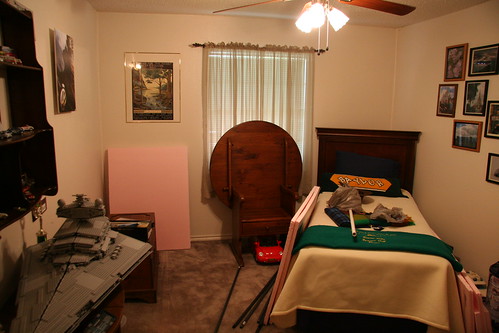
First, we have a shot of where the layout will go. Originally, the table/chair was in the table configuration, with the old layout on top of it. I removed the old layout and shuffled some things around. Wow! I have a lot more space here than I thought! Good to know.
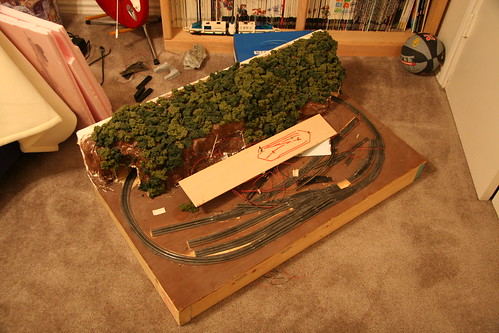
Speaking of the old railroad, here’s the final picture I took before hauling it to the dumpster this morning. I salvaged a bunch of turnouts, some insulated rail joiners, and three terminal strips. If you know me, you know how hard it is for me to throw things like this away (especially things that I spent several hard hours and several hundred dollars working on. But I was out of space and wanted to get the old one out of my sight. So off to the rubbish bin it goes!
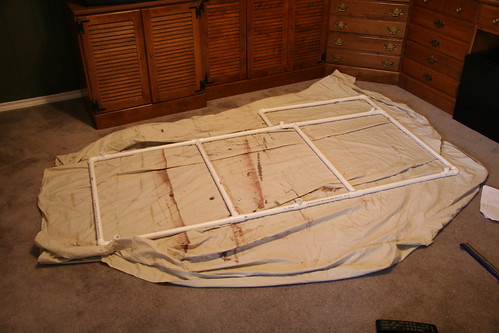
Next, we have a picture of the PVC frame that I built for the railroad. Not much to say, it’s a bunch of PVC pipes.

…and here is what it looks like on the legs. I’m still not sure about the stability of these legs, but we shall see. The nice thing is that thanks to snap on PVC fittings, I can easily change it. You can also see the foam that I got, too. More on that in a moment.

Finally, here is a picture of the foam being glued to the frame with Liquid Nails.
Since I last wrote, I picked up the 1” pink polystyrene foam insulation that will serve as the foundation for the railroad. I went to Home Depot for this, as Lowe’s only had ½” thick sheets. I really wanted a 2” sheet, but apparently they don’t have those in Texas. (This doesn’t make sense to me, because insulation is supposed to keep the air temperature stable inside the house, so why wouldn’t you want to use the thicker kind?).
The stuff is only sold in 4x8 sheets. Said sheets most definitely do NOT fit in a VW New Beetle. So I had to get them cut. I found a salesman to help me and he was more than happy to do so. Now, I thought we could just take them to the circular saw, make the four cuts, and be done with it. But apparently the guy that was helping me either didn’t think of that, or didn’t think it would work. So he tried cutting it with a regular razor blade. Well, that didn’t go over to well (it wasn’t deep enough), so he went off in search of better tools and returned with…a kitchen knife. No, not even a steak knife—a plain old kitchen knife.
Now, I’m internally laughing at this whole situation. Here we are in the HOME DEPOT of all places, and the best tool this guy can find is a kitchen knife. When this clearly won’t cut it (hah!), he goes off again and returns with a handsaw. Finally we make some progress and the foam is cut in minutes. I really was grateful for his help, though, and at no charge!
I got the foam home. It barely fit in the car, and now there are pink beads in the backseat! The first thing I did was vacuum each piece to remove excess beads. I tell you this stuff is a mess when it’s cut. It’s not as bad as the white-beadboard Styrofoam, but still bad. I should think about getting a hot-knife/wire for making the scenery out of this stuff.
Next, I set the layout up on the legs in the layout room. It’s actually fairly stable when up against the wall. With a sharpie, I marked the angle of the snap on leg supports, then hauled the whole frame outside and glued them in place with PVC cement. And man is that stuff noxious! But on the good side, it sets extremely quickly!
After yet another trip to the hardware store, I returned with some tubes of Liquid Nails for Projects. If you use this stuff, be absolutely certain you get the latex-based kind. The “normal” kind will eat through the foam! You apply the Liquid Nails using a caulk gun, which I had never used before. And man is it fun. I wish I had some things to caulk around the house, just so I could mess with it more.
I placed the frame on top of the pink sheets, carefully positioning them to get the closest fit. Despite my careful measurements, the pink sheets are a little bigger in spots then the frame (I’m guessing the 4x8 sheet isn’t “exactly” 4x8). But in the end, this isn’t a problem as I can easily cut the stuff later if I want. I marked the frame’s location on the foam with a sharpie, then lifted the whole thing up and applied a generous bead of Liquid Nails in the marked zones. I carefully set the frame back down, using the guidlelines and “eyeballing” it to ensure proper fit. Then I added beads of Liquid Nails along the sides of the frame. Finally, I laid some heavy college textbooks (thanks, Norton Anthology of American Literature, I finally found a use for you!) on top of the frame to weigh it down.
So that’s where I am at the moment. I’m hoping by the end of next week my track will be here, and I’ll be able to start working on a trackplan. I’m going to try and get my basic loop done first, and any turnouts will have to come later. I have been considering a double track main, but when I think about the prototype (small mining subsidiary), that makes no sense. So I’m still thinking about it.
Friday, April 10, 2009
I was framed!
Model Railroads don’t just hang in midair. They have to sit on “benchwork.” An evil word, to be sure, and one which I wish I didn’t have to deal with. I hate messing with benchwork. It’s a pain in the butt. My last layout, I used a traditional wood frame made of 2x4s, topped by a ½ inch thick sheet of cheap plywood. Of course, the wood was warped in about 5 minutes thanks to Waco’s wonderful humidity. So the whole layout was kind of “wompy-jogged.” Interesting fact: wood is heavy. You may not think so, since wood can float in water. But it is heavy. Now think: I’m still in college. This thing is going to be moved a number of times. See where I’m going? Bad idea.
So I was never really happy with the benchwork, but I put up with it, because unlike virtually everything else on the layout, you can’t rip up the benchwork and redo it. Once it’s done, it’s DONE.
So for this layout, I’m using “modern” construction method of pink/blue foam insulation. Of course, you still need some sort of frame to hold all this stuff. I wanted it to be lightweight, but still sturdy. My Dad had the suggestion that I use PVC pipe. The more I thought about this, the more I liked it. It’s strong, lightweight, and can be put together very quickly. My only concern was how I was going to build legs for it. Ideally you could get a coupling that was a corner with a third exit going down. But I didn’t see any of those online.
So, off I go to Lowe’s—the first of no doubt many trips.
The first thing I did at Lowe’s was check out the foam sheet situation. They had the blue variety, but only in ½ inch. 10 bucks a sheet. This was disappointing as I wanted 2 inch sheets. And $40 is a lot to spend on foam. So I decided to pass on that for the time being.
On to the PVC. When I finally found the stuff (oh yeah…the plumbing section, why didn’t I think of that), my eye caught hold of a 48” long pipe with threads on either end. Hey…that’s the exact height that I wanted my layout legs to be! I started looking at the various couplings available, and found a “T” that snaps on to the exterior of section of PVC, and has threads for screwing on the aforementioned legs. So…the legs problem has a potential solution.
Next I looked at the various lengths and sizes of PVC available. I had thought that I would want 1 inch, but quickly found out that was gigantic. ¾ inch looked about right. I was elated to find out that the pipe was available in 5 ft sections. I was worried that they would only have the big long sections and I would have to get someone to cut it for me. You can’t fit all this stuff in the back of a VW! So I picked up a scary-looking generic pipe cutting tool ($10 for something I’ll probably use once every 5 years at the most), five lengths of 5-foot ¾ inch pipe, 6 t-joints, and a bag of corners. I had initially planned on getting the foam, too, but I was disappointed with the ½ sheets and thought I would give Home Depot a try. So $45 later I’m on the way home.
I set up a cardboard table in the living room as a makeshift work bench—the guest bedroom (neé layout room) doesn’t have a TV, and there was a Doctor Who marathon on. Woot! Now, I had already drawn out the entire plan before hand, so theoretically it was just a matter of getting the various lengths of tubing cut.
I quickly realized, however, that this wasn’t going to be that easy. You see, PVC couplings don’t butt sections of pipe end-to-end. No, it adds about 1 inch to the inside. So I knew that I had to reduce my measurements some in order to end up with a finished product the size that I wanted.
Now for those of you that don’t know me that well, let me just say this: I hate math. I’m only good at math if I have an HP calculator. Oh, I do all right with something tangible, like Lego bricks. I can usually tell with a casual glance if a piece is 6, 8, or 12 studs long, and how many Lego units high it is. But to do real-world math, in my head? Forget that. If I want to do math in my head, I have to imagine a sheet of paper, and then imagine a pencil writing out the figures and physically doing the work.
The long and short of it is that I was wracking my brain trying to figure out exactly what needed to be cut, and I finally came to the conclusion that since I didn’t have the foam yet, it didn’t really matter as long as I was consistent across the board. So I decided that ½ inch would do it, and cut my first length of pipe.
Well, that was easy. Those aforementioned pipe-cutting shears I got cut through the PVC like butter. I used a “Quik-Grip” to hold the pipe to the cardboard table. Those things are great, by the way. You should get some if you don’t have any. Keep them around the house and in the car. Take them with you to work. You’ll always be able to get a grip on the situation.
The frame came together very quickly after that first timid cut. I would say it took about 30 minutes to get the whole thing cut out. Of course, I ended up being short about 1 foot of pipe. Sigh. Story of my life. Time for another trip to the hardware store. I decided to check out Home Depot this time. I was elated to find that they have 1 inch thick foam sheets for only 12 bucks, which means I can get two for $25 and have enough left over for most of the scenery. So I’ll be foam-buying tomorrow.
Frustratingly, Home Depot only had the ginormous lengths of PVC pipe, and not the five-foot lengths. I also couldn’t find the leg-pipes (I had determined that I needed at least two more. So I had to skip over to Lowe’s to pick up more pipe. After Lowe’s, I hit up Hobby Lobby to see what kind of stuff they had. Sure, I’m not laying track yet, but I will be soon, so I might as well go ahead and buy a bunch.
Well that’s where I hit my first major snag in this layout.
I scan the shelves (by the way, the checkout lines were 10-people deep. It’s like this EVERY Time I go to Hobby Lobby). Anyway, I scan the shelves. You got your Woodland Scenics (hey! You can get DPM buildings here now, too!), you got your Bachmann junk. Your Model Power slightly-better-junk…..Hey, wait a minute….where’s the Atlas Snap-Track? I don’t see any track. I look more closely. I don’t see ANY Atlas product at all.
WTF!? They’re only the world’s largest track manufacturer! How can you NOT carry them! I don’t know if Hobby Lobby and Atlas had a falling out or what, but they aren’t carried by them anymore. I checked Atlas’ store locator. Nope, nada, zilch.
Deterred, I decided to stop by the Local Hobby Shop. Now I haven’t been in this place in about 5 years. The last time I was there, they had inventory from the 70s gathering dust. A sad site, but I thought I would do the community good and give them my business.
I was not encouraged when I drove up and saw dusty model rockets in the place where previously there were dusty trains. Come to find out, he got out of the model railroad business years back.
Well…Shit! That means the closest place to buy track was TEMPLE. And I’m not driving 40 miles to find some dinky local hobby shop that has very little inventory. I considered driving to Dallas on Monday to go to Discount Model Trains (A GREAT Train store—lots of good stuff!), but I looked around online and found discounttrainsonline.com (not related to the aforementioned store). They offered flat $7.95 shipping on any size order. I quickly calculated and realized that I would spend double that in gas getting to Dallas. So I gave in and placed a $55 order with them. Hopefully they are good!
Anyway, after all that jazz and running around I was dead tired so after cutting the final piece and putting the frame together, I called it a day. I’m still not sure about the layout legs, yet…they are a little iffy. But more on that in the next post—and I’ll try to get some pictures up, too…
Tuesday, April 7, 2009
And so it begins...
Some of you may remember me from my previous blog, which detailed my adventures in the Baylor in Oxford program in the summer of 2005. I had a lot of fun writing that blog, but I ultimately decided that I would leave the blog be once the adventure was over. I have a hard time justifying posting random blatherings that no one really cares about—that’s what Twitter is for, after all! (follow Cameron_Talley if you want to know more!).
What then, you may ask, prompts the creation of this new abomination of literature on the interwebs? That is a good question. Given my philosophy on blogging, surely there is a method to this madness, some reason for this new insanity.
Of course there is. And what, pray tell, is that reason? I shall tell you.
The other day I was cleaning up the guest bedroom, and I looked at my dilapidated N Scale railroad, sitting and gathering dust in the corner. I had not touched it for nearly 3 years—ever since I moved to my current apartment. Suddenly I got the urge to run the trains a little bit, just for the heck of it. So I get out the transformer, hook everything up, set the toggle switches and…..nothing. No movement. I give the Kato Mikado a little nudge, and it inches forward, stuttering. It seems the track had gone without a cleaning for far too long. I finally got the Mike moving a little, only to have the train get stuck in the tunnel. The one I can’t access without moving the whole damn layout out from the wall.
Son of a bitch.
And I got to thinking. Why do I still have this thing? It was started when I was a Freshman at Baylor, in the dorm, 8 years ago now. It was constructed using old-style methods of 2x4 benchwork and a plywood base, which had promptly warped in the Waco humidity. It had 9.75” radius track throughout (the whole layout is only 2’ by 3’), which looks bad and runs even worse. The scenery was pretty ugly-looking, a poor first attempt that clearly needed a do-over. I was never going to be happy with this.
Dejected, I packed the power pack away and rerailed the locomotive and cars, parking them to gather dust once more. But as I looked at the Mike, and the Shay sitting woefully neglected behind it, the drive rods in my brain began to slowly turn. I began visualizing how the furniture could be moved. How I could have enough space for 11” curves (or greater!) and more than 14 inches of straight track. Most of all, my blood started getting that feeling again—a longing for soot and grime, good old West Virginia Coke, and a return to an era where there was no more beautiful a woman than a N&W Class A, her drivers spinning as she barreled down the line, bringing the fuel that propelled a nation.
So I’m going to do it. I’m going to scrap the old layout and start over. I’m going to take what I’ve learned and improve upon my last effort. I’m going to spend way more money than I have on trivial things like wiring and switches and tiny little plastic people (Which are damn expensive, by the way).
When it’s all said and done, I’m going to descend into that railroading euphoria, that madness, once again.
So to get off on the right track (I promise I will keep these puns to a minimum), let’s take a look at my old layout:

Yes, here it is, in all its glory. This is near the end of its life. It took nearly 5 years to get to this point. Ugly, isn’t it? Unfortunately, it’s all I had room for in the dorm. I made a lot of mistakes with this one, which I intend to rectify with this new layout. Some things I have learned to get us started:
- Benchwork first, then track plan. On this previous layout, I made the mistake of using paper Atlas track planning templates to block out (on posterboard) the track plan. But when I actually started laying track, I found that my carefully concocted plan wouldn’t actually work in the real world. It just didn’t fit together right. So from day one, there was compromise. Never again. I’ll build the basic benchwork, and then I’ll use the actual track to come up with a plan that fits without compromise (which only leads to headaches!)
- On the topic of benchwork: NO PLYWOOD. It’s so passé nowadays, anyway. All the cool model railroaders use foam. Of course, you still need a frame; My Dad suggested using PVC pipe, which is lightweight and strong. The old layout, which was built with 2x4s and a “plywood plains” top sheet, was a pain to move. It was heavy, and the flat plywood didn’t allow any kind of scenery contour. So I’m going with 2” foam on top of a PVC frame.
- No curves smaller than 11” radius. The previous layout was restricted to 9.75” curves. They look bad. They are tough on long steam locos—some will run, others will not. Same with rolling stock. So 9.75” curves are out.
- NO TUNNELS. I had the brilliant idea last time of putting a turnout in a tunnel. Not to mention the sharp curves in the tunnel. I did have access panels in the back, and they helped tremendously. Until I moved, and the layout had to be put in the corner, where I couldn’t get to the back very easily. You couldn’t reach the track to clean it. God forbid you had a derailment, too. It became a nightmare, and one of the primary reasons I haven’t messed with the layout for over 2 years. So, no tunnels. All the track will be exposed. Depending on the trackplan, I may use a scenic divider down the middle. It’s still up in the air at this point.
- Electro-frog switches, at least for mainline. I have had NO LUCK at all with the standard Atlas switches. They have a plastic frog, and my steam locos tend to stall. So I’m going to try and go with Electro-frog switches, which will complicate the wiring somewhat, but which will hopefully work better overall.
So there it is. I’ll be keeping track of my progress on this blog. I don’t know how frequent updates will be, but I’ll try to keep a pretty good update schedule. Of course, some of that depends on my progress! I’m going to set a tentative goal of having a golden spike run in about a month.
Until next time!
